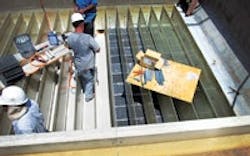Refurbishing Sand Filter Underdrains to Improve Hydraulic Capacity & Solids Removal Efficiency
The Traveling Bridge Sand Filter, also known as the automatic backwash filter (ABF) has been utilized on water and wastewater projects for more than 50 years. There are a number of reasons why the technology has had such staying power in an industry in which a number of newer technologies are utilized in the same applications. The ABF has a relatively simple design that provides low maintenance, is fully automatic, and delivers the high-quality effluent dictated by current reuse standards. It is this reliability that has allowed the ABF to be installed in nearly 1,000 plants nationwide.
Despite its design, as with many types of filtration devices, there are certain components of the filter that eventually need to be replaced. ABFs applied in wastewater applications typically utilize either sand or a combination of sand and anthracite. The filter media itself typically is replaced every few years, as the sand grains abrade over time, changing their size, shape and filtering ability. Additionally, the underdrain material, which usually is either HDPE or aluminum oxide porous plate, as well as the caulk used to seal the plates in place, wears or fouls over the course of the filter under-drain’s expected life of 15 to 20 years.
Upgrading ABFs
The Manatee County (Fla.) Southwest Water Reclamation Facility recently decided to upgrade some of its ABFs. The reason for addressing this issue was that the facility was able to pass a smaller volume of water through the filter before an appreciable amount of headloss would send it into an automatic backwash mode of operation. County personnel determined that even with proper maintenance and chemical cleaning, the filters had reached the point where the underdrains needed to be replaced.
Manatee has six 16-by-66-ft dual media configuration ABFs that were installed in the mid-1980s. According to Tom Birk, plant superintendent, some of the existing filters originally were installed with aluminum oxide porous plates and others were installed with HDPE porous plates. As the filters aged, plant staff noted that the backwash water from the filters with HDPE plates became clear, despite repeated chemical cleaning. The clarity of the backwash water was a sign that the backwash was not effectively cleaning the filter, and the underdrain needed to be replaced. The plant also wanted to rehab the underdrains because the filters with aluminum oxide porous plates could pass about 50% more flow than the filters with HDPE plates despite the fact that the filters were both 66 ft long. Plant staff also noted that the aluminum oxide plates were physically sturdier than the HDPE plates, which has allowed the plates in some of the existing filters to stand up to repeated backwashing and chemical cleaning without flexing or warping.
Underdrain Rebuild
After discussing options with Aqua-Aerobic Systems, Manatee decided to proceed on an underdrain rebuild of two of its filters, converting them from HDPE plates to aluminum oxide porous plates.
In addition to replacing the under-drains, the older media in the filters was removed and replaced with new sand and anthracite specifically sized for removing the finer solids present in the effluent stream after secondary clarification. The county also took this opportunity to assess the mechanical integrity of other filter components, leading it to rehab some of its bridge components as well.
Since completion of the project, Manatee has been pleased with the results of the revitalized ABFs, both from the standpoint of improved hydraulic capacity and the improved solids removal efficiency.
Download: Here
